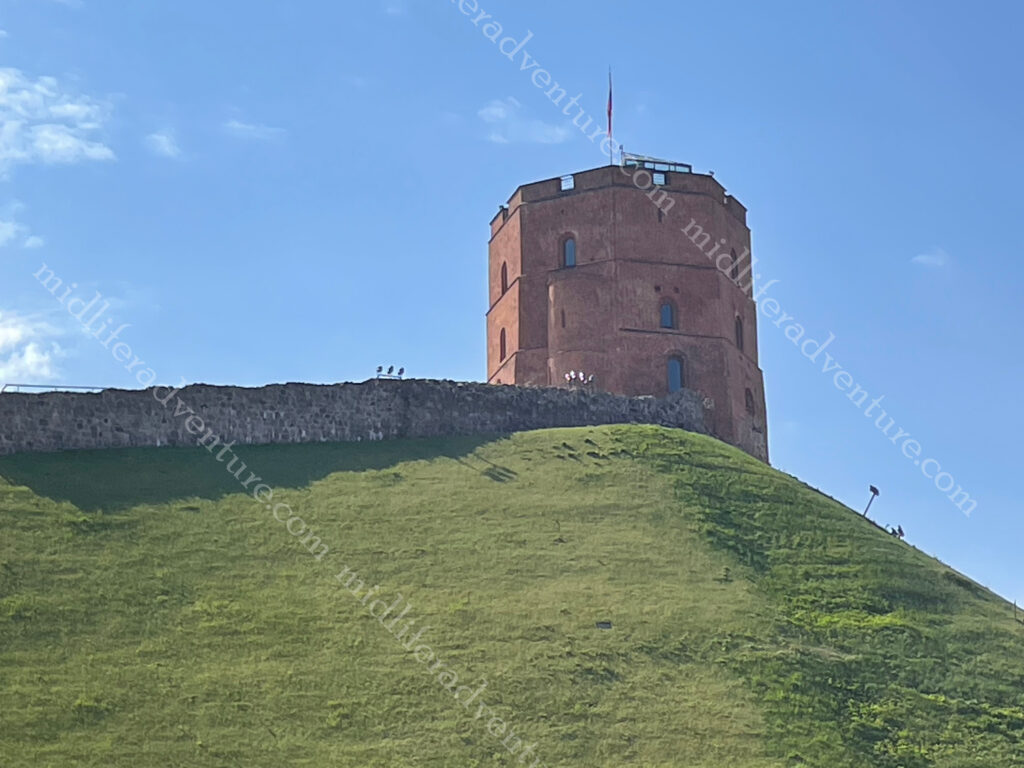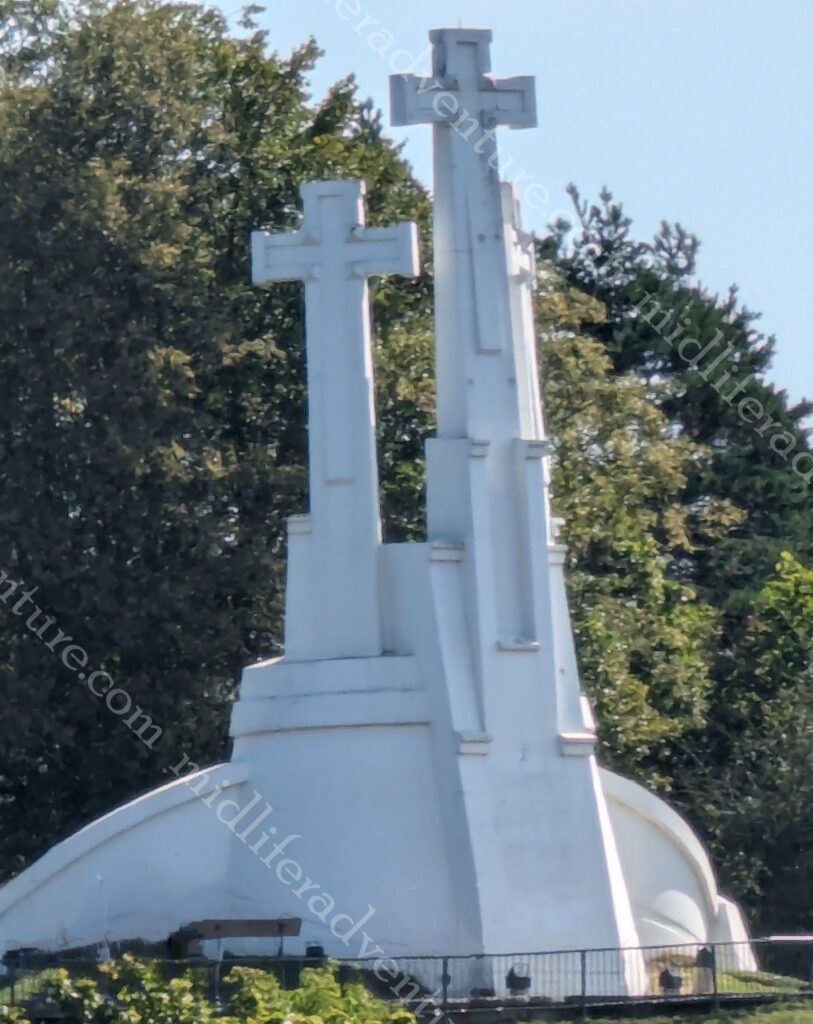
Lithuania is a developed country with a high income, advanced economy, ranking 37th in the Human Development Index (HDI) and 19th in the World Happiness Report (Australia is ranked 10 on both).
To be honest, I knew almost nothing about Lithuania before arriving here. We hopped a train from Poland and made our way to the Lithuanian capital of Vilnius. The city lies in the southeastern part of the country at the confluence of the Neres and Vilnius rivers.
Lithuanians , Poles , Jews and Belarusians have historically considered Vilnius as their cultural center. A university has been operating in Vilnius since 1579.
Legend of the Iron Wolf
According to the legend, centuries ago Grand Duke Gediminas, was on a hunting trip in the forests of Šventaragis valley around the mouth of the River Vilnia. When night fell, the party, feeling tired after a long and successful hunt, decided to set up camp and spend the night there. While he was asleep, Gediminas had an unusual dream in which he saw an iron wolf at the top of the mountain standing with its head raised proudly towards the moon, howling as loud as a hundred wolves.

The Duke remembered his dream and consulted the pagan priest about it. He was told that the dream was a direction to found a city among the hills.
The howling of the wolf represented the fame of the future city: that city will be the capital of Lithuanian lands, and its reputation would spread far and wide, as far as the howling of the mysterious wolf…’ So the Grand Duke Gediminas, obeying the will of gods, immediately started to build the future capital which took the name of Vilnius – from the stream of the rapid River Vilnia.
He built a fortress on the hill (Gediminas Tower) and the city of Vilnius grew up around it. You can still climb the hill and visit the Tower which provides one of the best views of this beautiful city. We however chose to pay 3 euros and use the funicular.

Hopping off the train we found ourselves in one of the cleanest and most cared for cities we have ever seen. This place was Japanese level clean and well tended for, certainly cleaner than anywhere we have ever been in Australia. Our hotel was a charming little joint, about 700m from the train station and right on the fringes of Old Town.
The oldest buildings in Vilnius were built in the 13th century. The main attraction is absolutely the Cathedral Square. It is not only the most important location in the city, but is also one of the most significant and widely known symbols of Lithuania.The square regularly hosts events such as: fairs and gatherings of townspeople, military parades, religious and official public events, attractions and large concerts, New Year’s salutes and exhibitions.





The main feature of the square is the Cathedral Basilica of St Stanislaus and St Ladislaus of Vilnius. The square was so important that it was the main feature on the 50 litas banknote (pre-euro), the layout included.

1. Vilnius Cathedral 2. Cathedral’s Belfry 3. Gediminas Tower 4. Hill of Three Crosses 5. Monument to Gediminas 6. Royal Palace
The Valdnieku (Grand Dukes) Palace , next to the Cathedral has been converted to house the history museum. Up the hill was Gediminas Castle Tower, which we took the funicular to reach the top. From here we got panoramic views over the city and surrounds.










The Three Crosses memorial consists of three white reinforced concrete crosses.
The hill got its name after Franciscans died as martyrs when pagans tied them to crosses and threw them down the hill. The three crosses were erected to commemorate this event.

At the bottom of the hill and the far (back) end of the Cathedral you find yourself in the Bernadine Gardens. We did the slow meander through here on our way to St. Anne’s Church. By this time the masses of tourists had crawled out of bed and were making seeing the sights unpleasant.









In an attempt to dodge some crowds for a while we found ourselves in a local cafe/bar where Jill found her long awaited steak tartare. She had been wanting one of these since Prague, but for a variety of reasons was unable to have one up until now. So that with some zeppelins (potato/meat dumplings) washed down with an Argentinian specialty (Aperol and fresh orange juice) and a local lager.





The sheer volume of beautiful old buildings and churches to be seen in and around Vilnius is astounding. And they are all (and I mean all) in perfect condition. There is no scaffolding, no graffiti, no shoddy paint. There is a real pride to the standard of the buildings, everywhere you look.









The Gate of Dawn, or Sharp Gate is a city gate that was built between 1503 and 1522 as a part of defensive fortifications for the city.
City gates often contained religious artifacts intended to guard the city from attacks and to bless travelers. The Chapel in the Gate of Dawn contains an icon of The Blessed Virgin Mary, Mother of Mercy, said to have miraculous powers.
Upon arrival we went hunting (online) about places to eat in the general vicinity of where we were. This is a common search for us on arrival in a town. The magic search phrases are restaurant near me, cheap eats near me, local food near me. We were surprised to find that the results trickled in rather than overwhelmed us.
Not finding anything that rang our bells, we decided to just wander about and see what we could see. What we found was an abundance of places to eat, but they were pop-up restaurants for the summer season. Not permanent fixtures but rather just places that took over open spaces and became an alfresco dining heaven.









The food was good, the prices were reasonable (maybe even cheap) and the setting was stunning. Warm (mid 20’s) summer evenings, cool beverages and great food offerings. This gave us some flashbacks of Spain and the way we lived back then.
To sum it all up, Lithuania was fantastic. We did not spend enough time here and will definitely put it on a list of places to come back to. August really is a spectacular time of year to visit here.